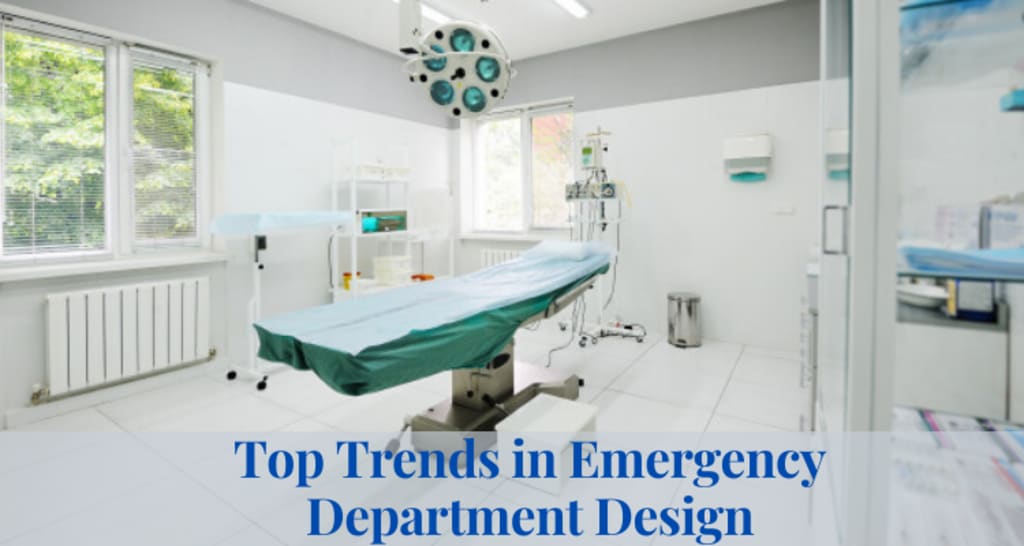Top Trends in Emergency Department Design
Emergency Department Design Enhance Productivity of Employees and Profit

The first phase for several people to enter a healthcare facility is an emergency room. It happens specifically for those with non-acute illnesses. There are a number of factors that can help exacerbate the condition and improve the waiting time, resulting in less customer and employee satisfaction.
Designs that can influence emergency planning include a number of alternative opinions and ideas that can help to build the ED of the future. Some of them are,
A nurse or doctor is placed at the door of the ED to perform an emergency examination.
A triage hall grouping of personnel service areas.
An accessible space with slopes separated by curtains or partitions. Space is often not filled.
A processing environment for fast-track emergency rooms weatherford, tx. It is also used to isolate patients from the general waiting room so that they are close to each other.
A dedicated waiting room, for those who are not yet eligible for discharge and who do not need a home.
A program to place people in a hospital facility, who need additional time but no longer requires ED treatment and do not have to be admitted.
In the Radiography or CT space in the ED.
A regular automated testing lab environment inside the ED.
A double-sided consultation area on the one hand exposed to patient movement and a central workstation on the other.
Emergency Department Design Increase Capacity and Profit
Due to a large number of patients who are not involved in crises, their performance is more important than ever before. Bringing these patients easily and rapidly through the network and into a treatment facility helps reduce overcrowding and long wait. The emergency department is also the primary source of the financial resources of a healthcare facility. 65% of hospital admissions, on average come from the Emergency Department, and up to 70% of ambulance operations come from Emergency Department experiences. The Emergency Department system architecture is among the most frequently talked about architectural issues in the healthcare sector.
Some of the important tips are:
For efficiency and safety and the interaction of patients, consistent directions of travel in an Emergency Department are important.
Finding ways is particularly important to help distinguish people from those who are stuck literally on their way to other places in the hospital.
With the help of simple signaling, color coding zones, and graphic enhancements, it is possible to improve the design.
Waiting area features
Until transitioning to hospital rooms, medical requirements must be addressed properly. This is vital as when non-acute patients are laid in bed and are deemed horizontal, the same highly skilled and multiple personnel will be handled as those with severe conditions.
Once designed to keep patients in a vertical or sitting role in our internal control regions, less specialist-oriented resources are expected to examine them properly. The use of reclining devices not only keeps patients seated but reduces the fear that can be stimulated for a long time.
Improved design of the room
For hospitals, particularly for emergency rooms, there is premium space. Patient safety can always be protected as the staff takes care of different patients in a single environment by placing several beds in an area and using partitions effectively.
Some of the innovative ways to improve the overall design are:
As there is no option to foresee when people come to an emergency department and what their problems might be, it is often difficult to arrange staff.
Operations must, therefore, be expanded and reduced when required. Each of the emergency departments needs proper staff based on the volume of patients in each of the pod setups.
When an ED is more sequential in nature, staff can be delegated to address personnel issues gradually.
Enhanced productivity of employees
Intelligent, compact architectural design will increase the productivity of emergency service workers by designing versatile spaces. Items like rolling panels, wheel furnishings, and flexible modules provide adaptability that makes it easy and simple for staff to adjust.
Make the organization a welcoming place
A first-time seat next to the entrance enables an appreciation of where to go for patients. This first concept of the individual is a friendly place for nurses or doctors who can determine the patient's attitude straight away.
Remove derogatory waiting room experiences
The hospital seats lined in rows make patients and family members reflect on their health concerns and exacerbate the stress reaction. It is calming to place them in a stimulating setting, in particular, because studies show that successful stimuli lead to emotional control.
Numerous seating choices, like tables and chairs, smaller furniture sets, various heights in the ceilings, help to improve the environment of an emergency care center in denton, tx. Unique lighting facilitates all of the activity without losing protection or accessibility.
Improve the pathway to recovery areas
It influences both the efficiency of the employee and the comfort of the patient population but is often not identified. It allows patients and families to find a specific room since they see bits of space that are more accessible and known than a long time. For workers too, this can be helpful.
About the Creator
Josh Argenton
Josh Argenton is a well-known blogger who has been writing blogs on a wide range of topics including technology, health & beauty, sports, business, food, entertainment, home improvements and much more.






Comments
There are no comments for this story
Be the first to respond and start the conversation.